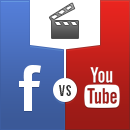Now, there are three data points that are publicly available for developing a lousy scale for YouTube brand channels: video views, subscribers, and uploaded videos.
I quickly decided against using “video views.” This seems like a more appropriate metric for comparing individual YouTube videos.
“Subscribers” is a more appropriate metric for comparing YouTube channels. Users subscribe to channels to receive updates and stay informed when something new occurs. Subscribers are consistently more engaged with a brand’s content and watch a brand’s videos on a regular basis.
VidStatsX provides a list of the top 2,000 most-subscribed YouTube channels. It also provides lists of the top 100 most-subscribed YouTube channels in 16 categories.
But, some YouTube brand channels were launched earlier than others, giving them a head start in adding subscribers. And is a channel lousy simply because it hasn’t made it to one of these lists yet?
On May 20, 2012, the YouTube Blog said there were “tens of millions of channels on YouTube.” So, even if a YouTube brand channel doesn’t make it to bottom of the top 100 most-subscribed YouTube channel’s list in its category, it might still be pretty good.
This is where “uploaded videos” factors into the lousy scale.
A very good YouTube brand channel should be able to generate more subscribers per uploaded video than other channels in its category. This means that a really bad — or lousy — channel would be one that has generated fewer subscribers per uploaded video than its competitors.
This methodology lets you calculate the equivalent of the batting average for a YouTube brand channel.
A pretty lousy branded YouTube channel in the auto and vehicle category
To take my new lousy scale out for a test drive, I started in YouTube’s automotive category. To my surprise, here’s what I found:
Brand Subscribers Videos Subscribers/Video
Audi Deutschland 95,173 893 106.6
Chevrolet 81,799 1,321 61.9
Mercedes-Benz 72,126 112 644.0
Ford 68,966 347 198.7
Honda 68,018 289 235.4
Cadillac 43,762 198 221.0
Hyundai USA 40,256 333 120.9
Toyota Deutschland 39,651 214 185.3
Volkswagen USA 36,535 211 173.2
Buick 2,059 434 4.7
Based on this data, Buick’s branded YouTube channel is pretty lousy. It has the lowest number of subscribers per video in the autos and vehicles category. By comparison, the Mercedes-Benz channel has generated 137 times more subscribers per video.
MORE: 3 lousy branded YouTube channels

